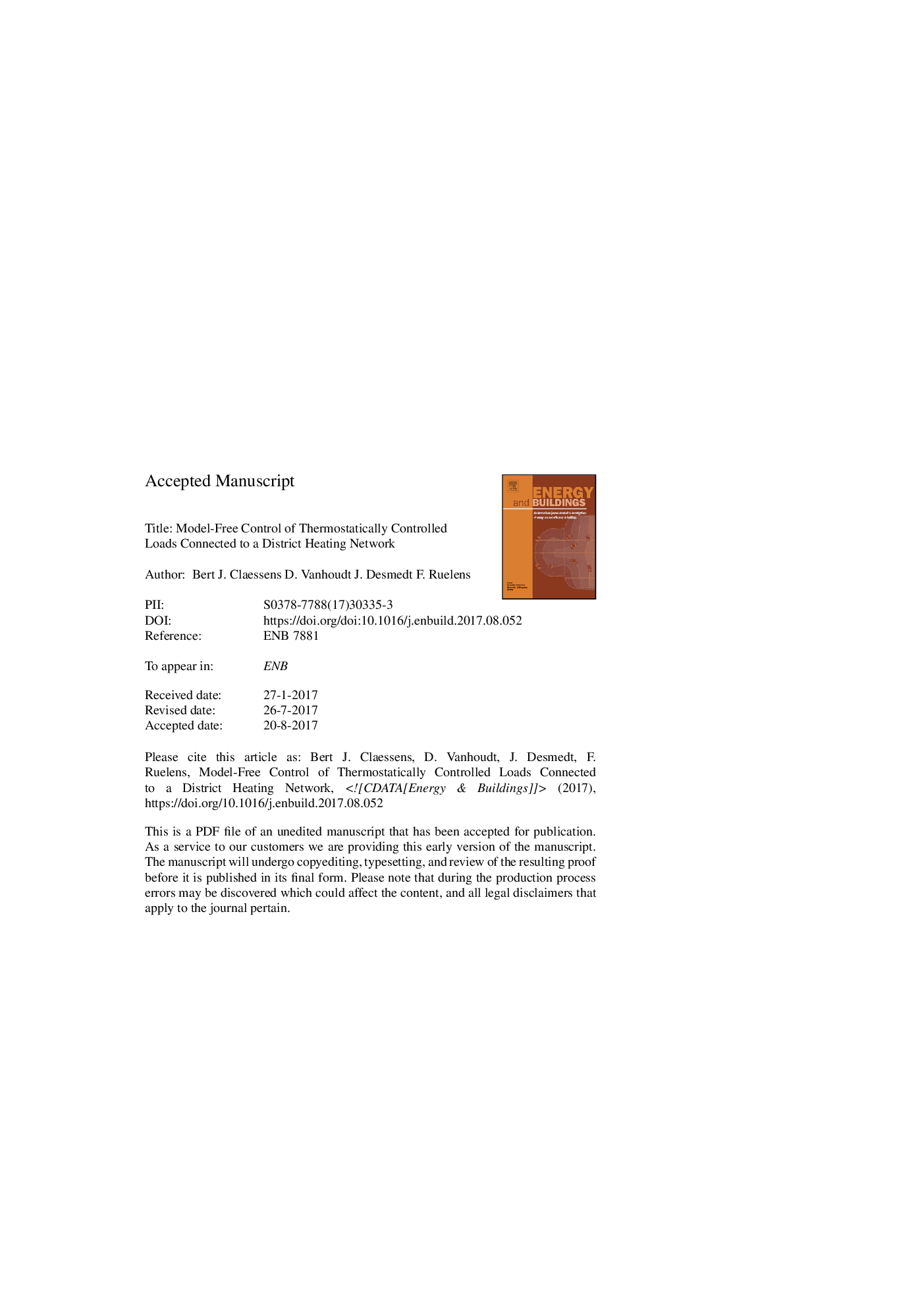| کد مقاله | کد نشریه | سال انتشار | مقاله انگلیسی | نسخه تمام متن |
|---|---|---|---|---|
| 6729069 | 1428931 | 2018 | 10 صفحه PDF | دانلود رایگان |
عنوان انگلیسی مقاله ISI
Model-free control of thermostatically controlled loads connected to a district heating network
ترجمه فارسی عنوان
کنترل مدل بارهای کنترل شده توسط گرماسخت کنترل شده به یک شبکه گرمایش مرکزی
دانلود مقاله + سفارش ترجمه
دانلود مقاله ISI انگلیسی
رایگان برای ایرانیان
کلمات کلیدی
گرمایش منطقه، ترکیب گرما و قدرت، تقویت یادگیری، بارهای تحت کنترل حرارتی،
ترجمه چکیده
کنترل بهینه کنترل بارهای ترموستاتا متصل به شبکه گرمایش مرکزی یک مشکل تصمیم گیری متوالی در عدم قطعیت است. عملی بودن یک رویکرد مستقیم مبتنی بر مدل با دو چالش مواجه شده است: مقیاس پذیری به دلیل ابعاد بزرگ مشکل و شناسایی سیستم مورد نیاز برای شناسایی یک مدل دقیق. برای کمک به کاهش این مشکلات، این مقاله بر روی پیشرفت های اخیر در یادگیری تقویت در ترکیب با یک سیستم چند منظوره مبتنی بر بازار به منظور به دست آوردن یک راه حل مقیاس پذیر که بهبود قابل توجهی در یک دوره یادگیری عملی به ارمغان می آورد. در مرحله اول، تمام اطلاعات مربوط به (و عملا در دسترس) دولتی جمع آوری می شود که مجموعه ای از ویژگی های محدود استخراج می شود و منجر به نمایش نمایشی کم حالت در حالت سیستم می شود. در مرحله دوم، یک عمل کنترل برای کل خوشه از یک خط مشی تعیین شده آفلاین استخراج می شود. در مرحله سوم و نهایی، این عمل کنترل بر روی بارهای مختلف ترموستاتا کنترل شده با استفاده از یک سیستم چند منظوره مبتنی بر بازار ارسال می شود. این فرآیند پس از یک رویکرد افق عقب افتاده تکرار می شود. رویکرد کنترل به یک سناریو شامل 100 بار بارگیری شده توسط ترموستاتا وصل شده به یک شبکه حرارت مرکزی شعاعی عرضه شده توسط یک گرما و نیروگاه مرکزی مرکب اعمال می شود. هر دو برای یک آربیتراژ انرژی و یک هدف قشری اصلاح، رویکرد کنترل نیاز به 60 روز برای به دست آوردن عملکرد در 65٪ از حد پایین تئوری پایین هزینه.
موضوعات مرتبط
مهندسی و علوم پایه
مهندسی انرژی
انرژی های تجدید پذیر، توسعه پایدار و محیط زیست
چکیده انگلیسی
Optimal control of thermostatically controlled loads connected to a district heating network is considered a sequential decision-making problem under uncertainty. The practicality of a direct model-based approach is compromised by two challenges, namely scalability due to the large dimensionality of the problem and the system identification required to identify an accurate model. To help in mitigating these problems, this paper leverages on recent developments in reinforcement learning in combination with a market-based multi-agent system to obtain a scalable solution that obtains a significant performance improvement in a practical learning time. In a first step, all relevant (and practically available) state information is collected from which a limited set of features is extracted, resulting in a low-dimensional representation of the system state. In a second step, a control action for the entire cluster is extracted from a policy determined offline. In a third and final step, this control action is dispatched over the different thermostatically controlled loads using a market-based multi-agent system. This process is repeated following a receding horizon approach. The control approach is applied to a scenario comprising 100 thermostatically controlled loads connected to a radial district heating network supplied by a central combined heat and power plant. Both for an energy arbitrage and a peak shaving objective, the control approach requires 60 days to obtain a performance within 65% of a theoretical lower bound on the cost.
ناشر
Database: Elsevier - ScienceDirect (ساینس دایرکت)
Journal: Energy and Buildings - Volume 159, 15 January 2018, Pages 1-10
Journal: Energy and Buildings - Volume 159, 15 January 2018, Pages 1-10
نویسندگان
Bert J. Claessens, D. Vanhoudt, J. Desmedt, F. Ruelens,
